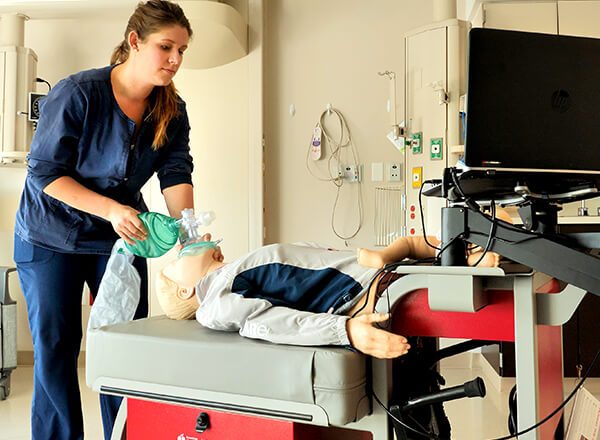In critical moments, the right resuscitation skills can make all the difference. For healthcare providers, mastering basic life support (BLS), advanced cardiovascular life support (ACLS) and pediatric advanced life support (PALS) is essential to ensure the best possible outcomes for their patients.
As the authority in resuscitation science, research and training, the American Heart Association® publishes the official AHA Guidelines for CPR & ECC. The AHA then translates these guidelines into the highest quality training materials, courses and programs in CPR, first aid and advanced emergency cardiovascular care for healthcare professionals, first responders and support staff.
Each program caters to different levels of expertise and patient demographics, providing essential skills for lifesaving interventions. Here's an overview of the distinctions between BLS, ACLS and PALS, their curricula and their significance in hospital settings.
Basic Life Support (BLS)
BLS training provides foundational resuscitation skills essential for all healthcare providers. The curriculum focuses on:
-
Effective CPR Techniques
High-quality chest compressions, rescue breaths and bag valve mask use
-
AED Implementation
Recognition of sudden cardiac arrest and automated external defibrillator use
-
Choking Relief
Techniques for relieving airway obstructions in both conscious and unconscious patients
BLS certification is mandatory for healthcare providers working in hospitals. This program ensures every provider is equipped with the basic skills needed to respond to cardiac emergencies, which are critical in the first few minutes before advanced help arrives.
Advanced Cardiovascular Life Support (ACLS)
ACLS builds upon BLS, including effective chest compressions, bag valve mask use and AED use. However, ACLS training also covers advanced skills for managing cardiac emergencies, including:
-
Early Recognition
Early management of pre-arrest conditions such as symptomatic bradycardia
-
Advanced Airway Management
Treating intubated patients and using advanced airway devices
-
Pharmacology
Administering medications used in sudden cardiac arrest and other cardiovascular emergencies
-
Electrical Therapy
Using defibrillation, synchronized cardioversion and pacing
-
Cardiac Arrest Algorithms
Structured approaches to managing different types of sudden cardiac arrest and post-cardiac arrest care
ACLS is designed for healthcare providers directly involved in managing cardiopulmonary arrest or other cardiovascular emergencies, such as those working in emergency departments and critical care units. It emphasizes the need for prompt, organized and effective responses, which are crucial for improving patient outcomes during life-threatening situations.
Pediatric Advanced Life Support (PALS)
PALS is tailored to address infants' and children's resuscitation needs by equipping healthcare providers with the skills to identify and address respiratory emergencies, shock and cardiopulmonary arrest. It emphasizes the importance of high-performance teamwork and individual skills. The curriculum covers:
-
Pediatric Assessment
Systematic approach to pediatric assessment and differentiating between patients who do and don't require immediate intervention
-
Pediatric Basic Life Support
Age-appropriate techniques for CPR and AED use
-
Pediatric Advanced Interventions
Advanced airway management, vascular access and medication use in pediatric emergencies
-
Pediatric Cardiac Arrest Algorithms
Guidelines for managing respiratory failure, shock and sudden cardiac arrest in pediatric patients
PALS is critical for healthcare providers who care for pediatric patients, including those in pediatric wards, emergency departments and critical care units. It ensures providers can recognize and manage the unique challenges of pediatric emergencies to enhance young patients' chances of survival and recovery.
Key Differences Between BLS, ACLS and PALS
Although BLS, ACLS and PALS share common goals of improving patient outcomes through effective resuscitation, their scope and focus differ.
-
Patient Demographics
BLS applies to all age groups, while ACLS is focused on adult patients and PALS is dedicated to pediatric patients.
-
Level of Care Administered
BLS provides fundamental skills, while ACLS offers advanced interventions for cardiac emergencies. PALS addresses infants' and children's specific needs.
-
Training Requirements
BLS is required for all healthcare providers. ACLS and PALS are essential for those working in specialized areas where advanced resuscitation skills are necessary.
Understanding the Chain of Survival
BLS, ACLS and PALS training incorporate the American Heart Association's Chain of Survival, which includes six links designed to maximize outcomes during cardiac emergencies. The chain of survival links are:
1. Activation of Emergency Response
Recognize the emergency and call for help.2. High-Quality CPR
Perform chest compressions and rescue breaths adequately and effectively.3. Defibrillation
Use an AED to restore a normal heart rhythm.4. Advanced Resuscitation
ACLS and PALS cover advanced airway management, pharmacology and cardiac arrest algorithms.5. Post-Cardiac Arrest Care
Provide critical care to stabilize the patient after resuscitation.6. Recovery
Support the patient's rehabilitation and long-term recovery.While BLS training lays the groundwork with high-quality CPR and AED use, ACLS and PALS include more comprehensive resuscitation care for different patient populations.
Additional Considerations for Healthcare Providers
Healthcare providers should consider the following as they practice and maintain their ACLS vs. BLS and PALS resuscitation skills.
-
Continuous Education
Regular training and recertification are vital to maintaining proficiency in BLS, ACLS and PALS. Healthcare providers must stay updated with the latest guidelines and protocols.
-
Simulation Training
Incorporating simulation-based training can enhance skill retention and confidence. It allows providers to practice in realistic scenarios and receive immediate feedback.
-
Interdisciplinary Collaboration
Effective resuscitation often requires teamwork. Providers should engage in interdisciplinary training to improve communication and coordination during emergencies.
Ensuring the Right Response at the Right Time
Understanding the distinctions between BLS vs. ACLS vs. PALS while spreading awareness of the role CPR and AEDs can play in lifesaving scenarios is critical. Thanks to the enhanced competency and heightened confidence created through routine staff education, healthcare providers can help improve patient outcomes.
Explore the Resuscitation Quality Improvement (RQI) Program to learn more about its quarterly approach to high-quality resuscitation training.









